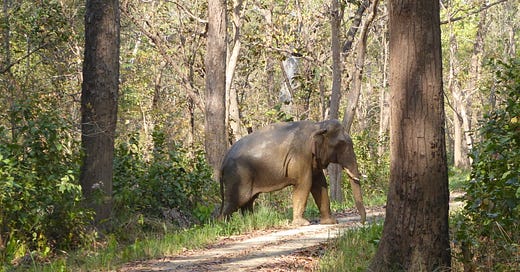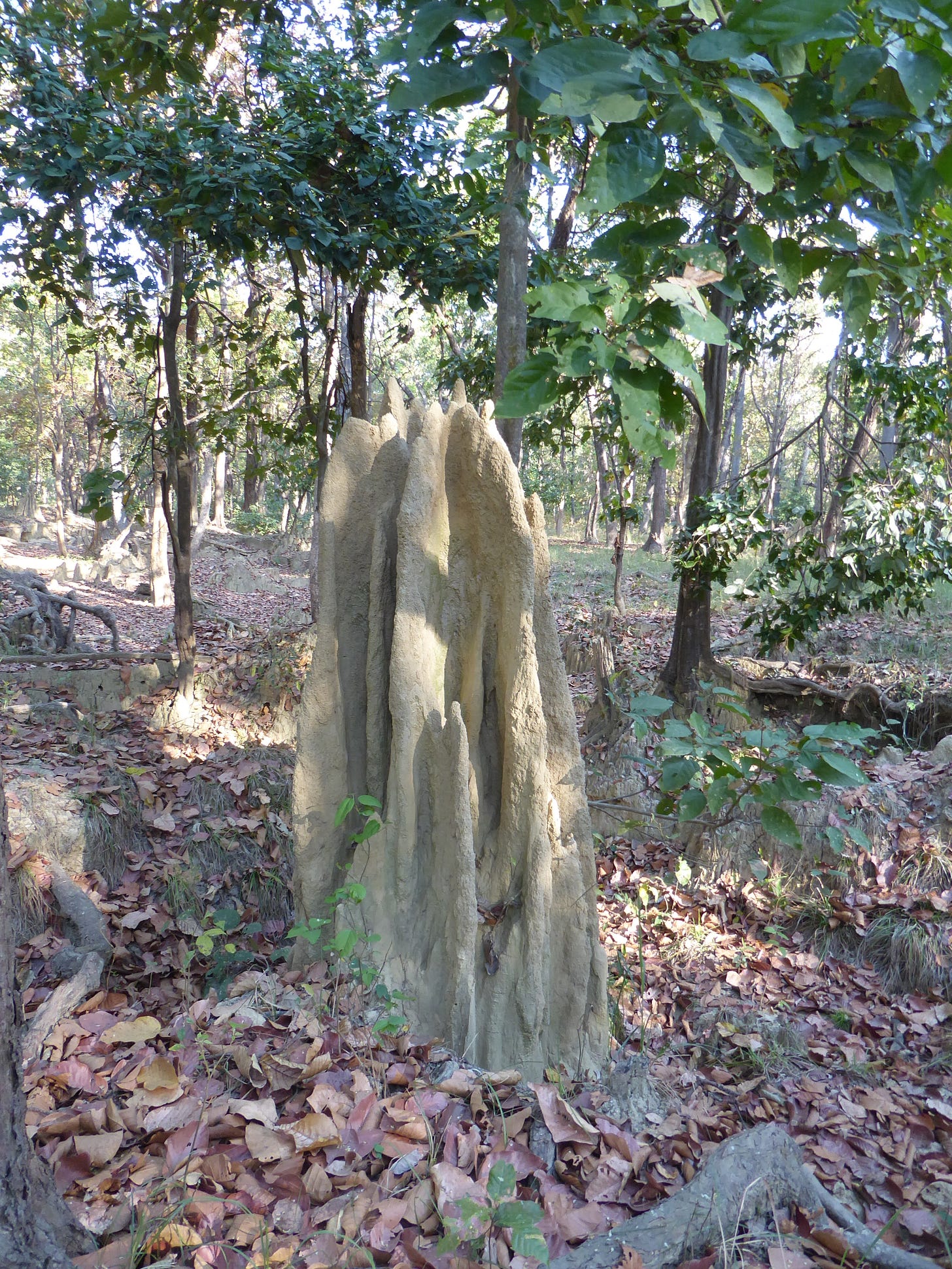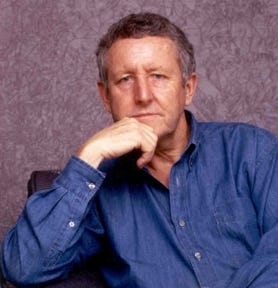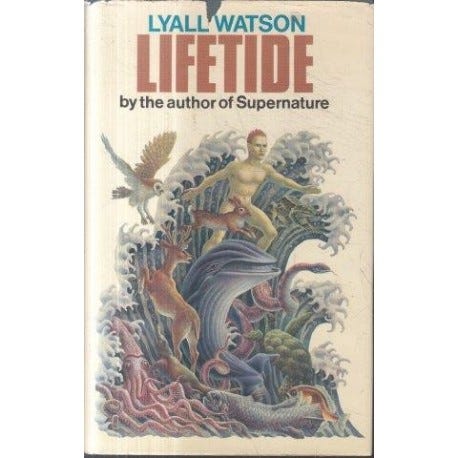‘Supernature Returns:’ the book I didn’t write
...with 25% more elephants (and maverick biologists)
April 2023: I sat in a Land Rover, being driven through the sal forest of Bardiya National Park in Nepal. This was the second day of my visit to the park. The morning was bright. The foliage was green and lush. And I had an idea.
Bardiya is a mixture of forest and open grassland. Deer are abundant, and we’d already passed several herds, grazing in the open and under trees. Troops of langur monkeys sheltered under thick, leafy canopies. I saw large bee’s nests, high in the trees. Species of multicoloured butterflies fluttered over the undergrowth. Myriad species of bird flew through the still-fresh air or perched on grass or branch. We’d already driven through tiger territory.
Our hopes for the day were high. The previous day we’d seen a tiger on one of the tributaries of the Karnali river. The tell had been a large flock of spotted deer, fleeing across the shallow tributary. The tiger was hidden in the tall grass of a riverbank, and we’d got a good view of him sloping off into the undergrowth.
Then we’d encountered a male elephant in musth. Musth is when a bull elephant becomes temporarily randy and aggressive during sexual heat. During this period elephants secrete a substance from cheek glands which they daub on vegetation. We’d already seen this substance daubed on some leaves. The elephant passed about ten metres behind the land rover, across the road. The drivers kept the motor running, in case he charged. Fortunately, he stomped off into the forest.
The forest had another feature: large, sand-coloured, fluted termite mounds. These mounds were everywhere, and I got the opportunity to examine a large one up close when the Land Rover got a flat tyre right in the middle of tiger territory. The guide gave me permission to go look at a nearby mound more closely.
The mound sat in a circle of trees. It had large supporting buttresses and flutings. The fluting is part of an ‘air-conditioning’ system that allows air circulation inside the mound. The termites were out of sight, within the mound itself, and tend to be active outside mainly at night.
The tyre repaired, we continued along the rough and bumpy track. My writer’s brain was working. Termites were potentially a terrific opening theme for a book. Termite mounds are far more than fairly anonymous sandy heaps: they’re subtle feats of animal engineering. Take the mound ventilation system. In 2019, some scientists had released a report after x-raying termite mounds. Their aim was to study the mounds in order better to design human ventilation systems. One of the researchers, Dr. Kamaljit Singh, had stated that“termite nests are a unique example of architectural perfection by insects”.
I was also aware that stranger claims had been made about termites. From about 1905, the South African lawyer Eugène Marais, dogged by depression, retired to the Waterberg wilderness area north of Pretoria. Marais was a keen amateur naturalist, and was fascinated by Termites. He wrote up his observations in a book entitled Die Siel van die Mier in 1937. The book is better known by its English title — The Soul of the White Ant. In this book, Marais speculated about the “psyche or soul” of the termite.
He wrote of the “mysterious power that governs” collective termite behaviour.1 Marais did not think that termites were governed by intelligence but by instinct. However, the nature of that collective instinct remained a mystery to him.
Especially odd was the termite’s reaction to an experiment he performed on the mound. He made a breach, then took a metal plate that was wider and higher than the mound and drove it right through the middle. This was so that one section of the community would never be in touch with the other. Despite this separation, Marais reported that “The termites build a similar arch or tower on each side of the plate. When eventually you withdraw the plate, the two halves match perfectly after the dividing cut has been repaired”. Marais suggested that “we cannot escape the conclusion that somewhere there exists a preconceived plan which the termites execute”.2
As the jeep bounced along the rough road, the book opening was taking shape in my mind. I’d describe the morning encounter with the mound, supply some fun facts about termites, and then look at Marais’ work. This would be a good segue into a broader discussion of life, mind and consciousness. Marais’ experiment might be a good way to introduce anomalous phenomena associated with life and mind. I even had a book title: Supernature Returns.
Lyall Watson
The book, in fact, would be a kind of sequel. Not to a book I’d written, but a follow-up to the work of a writer and biologist named Lyall Watson. Watson was born in South Africa and lived in Ireland but spent a good deal of his life globe-trotting. He had multiple degrees in anthropology, chemistry, botany and ethology and got a doctorate at London University in 1963. He was a global adventurer: one obituary reported that he ran a safari company in Kenya, created a whale sanctuary in Kenya, trekked the Amazon with a tapeworm named Fred and travelled to Antarctica. He was also fascinated by strange phenomena.
In 1973, Watson published a bestseller called Supernature. This was an attempt to bring biological and evolutionary science together with a study of the paranormal. The book examined a fairly motley collection of topics: astrology, the physics of life, psychokinesis, palmistry, hypnosis, dreams, hallucinations, time, precognition and exobiology. Interspersed with these somewhat esoteric topics were discussions of biology, animal behaviour and evolution.
Watson’s was fascinated by what he called the “soft edges” of science, and in a later work stated that he had tried in Supernature to
Redefine this fringe, to reconcile nature with what seems to be supernatural…. To create a sort of demilitarised zone into which both scientists and enthusiasts could go without abandoning either their sense of proportion or their sense of wonder.3
Watson died in 2008. Perhaps predictably, his obituaries were fairly dismissive of this paranormal interest. The University World News was contemptuous of his “wacky” ideas and the Guardian spent a chunk of their article debunking his “credulous…flights of fancy”. This was a world away from contemporary reviews of Supernature. The back cover of the first edition included positive comments from New Scientist, of all places, praising the book as “compelling reading for anyone who’s prepared to lay aside the blinkers of conventional thinking….” Well, conventional thinking won, culturally speaking, and by 2008 it was acceptable to dismiss this aspect of Watson’s work with a handwave.
This summary dismissal seems premature to me, and not entirely fair. The things Watson discussed were not uniformly improbable. The “wacky” ideas the University World News condemned included claims that “plants are sentient, dull razor blades will sharpen if left overnight under a cardboard model of a pyramid and that oysters possess a tidal memory”. First, Watson was only reporting ideas that were current at the time. He claimed to have tested the admittedly unlikely cardboard pyramid claim himself: I invite the reader to do the same and see if anything happens.
Plant sentience: Watson here was reporting a study that was conducted in the 1960s by Cleve Backster, who attached a plant to a lie detector and thought he’d detected emotional responses.4 Backster claimed the plants might also be telepathic: he thought he’d found a response when he decided to burn a leaf. These claims were indeed convincingly debunked via a follow-up study by J.M. Kmetz in 1978, several years after the publication of Supernature.5 However, the more general question of plant sentience, reframed in a more conventional ways, has recently once more become of scientific interest.
As for the tidal memory of oysters: these claims deserve serious consideration. Watson was reporting on the then heretical work of a biologist named Frank Brown.6 Brown took oysters dredged off the seabed at New Haven, Connecticut and transported them hundreds of miles to Evanston, Illinois. Kept in pans in a darkroom, these oysters gradually changed their feeding pattern times to open when the local tides would have been, if Evanston had been coastal. Brown thought that they might be responding to the local state of the moon.
Reporting these findings effectively trashed Brown’s career. His critics were brutal; Lamont Cole in Science accused Brown of discovering the “exogenous rhythm of the unicorn”.7 However, recent times have seen the rise of the science of chronobiology. Chronobiology, according to Wikipedia, “is a field of biology that examines timing processes, including periodic (cyclic) phenomena in living organisms, such as their adaptation to solar- and lunar-related rhythms”. This has given a scientific context in which to reappraise Brown’s work. In short: Brown’s observations might not have been so ‘wacky,’ after all, and deserved the consideration that Watson gave to them.
As a general rule: so-called ‘fantastic claims’ need to be examined and assessed on a case-by-case basis. Generic dismissive and contemptuous responses really will not do.
The dodgy bits
The flaws in Watson’s approach do, however, need highlighting. Watson was a beautiful writer, had a poetic imagination and this sometimes worked against him. He was prone in his books and interviews to get carried away by flights of fancy. For example, in one radio interview he claimed that when Charles Darwin’s sailing ship Beagle arrived at Tierra del Fuego, the inhabitants did not notice the ship because it was “too big to be encompassed by their imaginations” (About 14 minutes in). This claim is simply wrong, as a quick look at Darwin’s Voyage of the Beagle confirms. Darwin reports that on sighting the Beagle some nearby inhabitants “sprang up, and waving their tattered cloaks sent forth a loud and sonorous shout”.8
Watson was also prone to make what we might call ‘fantastic claims’ with insufficient evidence. For example his 1979 book Lifetide opens with a description of a visit to Venice. He’d been invited by the father of a little girl named Claudia who had the curious ability to turn tennis balls inside out. His description is certainly mesmerising:
[Claudia] favoured [her father] with one of her discerning looks and, almost in resignation…turned her attention to the ball…. she stroked it gently with her right as though it were a small furry animal, a dormouse to be roused from untimely hibernation…. [then] the dormouse broke all rules and responded.
One moment there was a tennis ball…. Then it was no longer so. There was a short, implosive sound, very soft, like a cork being drawn in the dark, and Claudia held in her hand something completely different. A smooth, dark, rubbery globe with only a suggestion of the old pattern on its surface – a sort of negative, through-the-looking glass impression of a tennis ball.”9
Watson reports later cutting the ball open to confirm that it was indeed same ball. He also states that Claudia was able to do the ‘trick’ again for him, allowing him to keep another inverted ball. Watson, however, shows a curious lack of excitement over these miraculous events. He didn’t have the ball X-rayed or analysed. He didn’t even photograph this object!
I actually wrote to Watson about the inverted tennis ball in the 2000s, care of his publishers, and he was gracious enough to reply. He stated that he’d lost the ball in a house move. So this remains a fantastic claim without any substantial backing. Did he make it up? His niece, who largely honoured her uncle, did acknowledge that he was prone to tell amazing stories which she often took “with a pinch of salt”. So who knows.
The best laid plans….
Despite these flaws, I liked the format of Supernature and it sequels. They brought together fascinating topics in a way that was poetic, entertaining and thought-provoking. I wanted to honour this with a modern version of Supernature. And on that morning, in the sal forest of Nepal, it seemed a wonderful idea.
So what happened? Three words: the writing process. But also, really, my own voice. I wrote a draft of the first chapter and realised that it wasn’t as compelling as it should have been. Later, I transferred the ‘termite opening’ to a chapter on the nature of life. Eventually, I cut that chapter, too, because I felt it distracted too much from the main arguments about consciousness.10 What emerged was significantly different from the original ‘Supernature Returns’ concept. But this happens. Kubrick and Clarke’s initial ‘Journey Beyond the Stars’ concept was very different from the final movie 2001: A Space Odyssey.
Still, I like to think that something of the spirit of Watson’s work is reflected in What Lies Beyond. For me his gift was to try and understand paranormal experiences not as something ‘spooky’ or ‘other’ but as integral parts of human biology, evolution and consciousness. His basic claim, that experienced reality is in part a construction of consciousness, is now actively discussed by some cognitive scientists.11 So perhaps Watson wasn’t totally ‘wacky’, after all.
References
Marais, E. (2018/1937). The soul of the white ant. [Kindle] (De Kok, W., Trans). A distant Mirror.
Marais, 2018/1937.
Watson, L. (1987). Supernature II. Sceptre, p. 13.
Backster, C. (1968). Evidence of primary perception in plant life. International Journal of Parapsychology 10, p.4.
Kmetz, J. M. (1978). Plant primary perception: The other side of the leaf. Skeptical Inquirer, 2, 59-61.
Brown, F.A. (1954). Persistent activity rhythms in the oyster. American Journal of Physiology 178, 510.
Cole, Lamont C. (1957). Biological Clock in the Unicorn. Science 125 (3253), 874–876.
Darwin, C. (1989). Voyage of the Beagle. Penguin, p.171.
Watson, L. (1979). Lifetide. Hodder & Stoughton, p. 18.
The missing chapter will be published on this blog next year after What Lies Beyond is published.
Hoffman, D.D. (2019). The case against reality: how evolution hid the truth from our eyes. Allen Lane.








